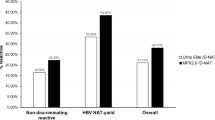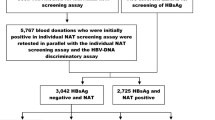Abstract
To analyze the risk and reason of false-negative HBV DNA results of NAT reagents among blood donations of China and discuss the necessity of two amplification targets for HBV DNA tests among donations. In this study, samples that showed discordant results on two commercially available assay platforms were further detected by established in-house methods based on conserved regions of the HBV genome. The HBV concentration of these samples was determined using two commercially available reagents. The samples with high titers of HBV were detected by an in-house method. The samples showing high Ct differences between two regions in the in-house method were further sequenced and aligned with primers and probes. The results showed that the established method has a good detection performance. The mismatch between reverse primers and sample sequences led to decreased detection capacity of S and C regions by the in-house method, but it could be compensated by another region. Among the false-negative samples detected by commercial reagents, most were because of low titers; however, there were 7 samples with HBV DNA concentrations much higher than the LOD of the commercial reagents, which may be due to mismatch of the primer or probe. This study highlights the potential risk of HBV false-negative detection by commercial NAT reagents. The dual-target assay may be helpful for HBV screening and reduce the risk of false-negative detection.


Similar content being viewed by others
References
Custer B, Sullivan SD, Hazlet TK, Iloeje U, Veenstra DL, Kowdley KV (2004) Global epidemiology of hepatitis B virus. J Clin Gastroenterol 38:S158–S168
Liang X, Bi S, Yang W, Wang L, Cui G, Cui F, Zhang Y, Liu J, Gong X, Chen Y, Wang F, Zheng H, Wang F, Guo J, Jia Z, Ma J, Wang H, Luo H, Li L, Jin S, Hadler SC, Wang Y (2009) Epidemiological serosurvey of hepatitis B in China—declining HBV prevalence due to hepatitis B vaccination. Vaccine 27:6550–6557
Liu GC, Sui GY, Liu GY, Zheng Y, Deng Y, Gao YY, Wang L (2013) A Bayesian meta-analysis on prevalence of hepatitis B virus infection among Chinese volunteer blood donors. PLoS ONE 8:e79203
Liu C, Chang L, Ji H, Guo F, Zhang K, Lin G, Zhang R, Li J, Wang L (2016) Prevalence of HBV DNA among 20 million seronegative blood donations in China from 2010 to 2015. Sci Rep. 6:36464
Echevarría JM, Avellón A (2006) Hepatitis B virus genetic diversity. J Med Virol 78(Suppl):S36–S42
Girones R, Miller RH (1989) Mutation rate of the hepadnavirus genome. Virology 170:595–597
Tipples GA, Ma MM, Fischer KP, Bain VG, Kneteman NM, Tyrrell DL (1996) Mutation in HBV RNA-dependent DNA polymerase confers resistance to lamivudine in vivo. Hepatology 24:714–717
Dos Santos MIMA, Pacheco SR, Stocker A, Schinoni MI, Paraná R, Reis MG, Silva LK (2017) Mutations associated with drug resistance and prevalence of vaccine escape mutations in patients with chronic hepatitis B infection. J Med Virol 89:1811–1816
Lindh M, Hannoun C, Malmström S, Lindberg J, Norkrans G (2006) Lamivudine resistance of hepatitis B virus masked by coemergence of mutations in probe region of the COBAS AMPLICOR assay. J Clin Microbiol 44:2587–2589
Liu C, Chang L, Jia T, Guo F, Zhang L, Ji H, Zhao J, Wang L (2017) Real-time PCR assays for hepatitis B virus DNA quantification may require two different targets. Virol J 14:94
Chudy M, Weber-Schehl M, Pichl L, Jork C, Kress J, Heiden M, Funk MB, Nübling CM (2012) Blood screening nucleic acid amplification tests for human immunodeficiency virus Type 1 may require two different amplification targets. Transfusion 52:431–439
Shah K, Ragupathy V, Saga A, Hewlett I (2016) High sensitivity detection of HIV-1 using two genomic targets compared with single target PCR. J Med Virol 88:1092–1097
Tsoi WC, Lelie N, Lin CK (2013) Enhanced detection of hepatitis B virus in Hong Kong blood donors after introduction of a more sensitive transcription-mediated amplification assay. Transfusion 53:2477–2488
Taira R, Satake M, Momose S, Hino S, Suzuki Y, Murokawa H, Uchida S, Tadokoro K (2013) Residual risk of transfusion-transmitted hepatitis B virus (HBV) infection caused by blood components derived from donors with occult HBV infection in Japan. Transfusion 53:1393–1404
Larralde O, Dow B, Jarvis L, Davidson F, Petrik J (2013) Hepatitis B escape mutants in Scottish blood donors. Med Microbiol Immunol 202:207–214
Allain JP, Mihaljevic I, Gonzalez-Fraile MI, Gubbe K, Holm-Harritshøj L, Garcia JM, Brojer E, Erikstrup C, Saniewski M, Wernish L, Bianco L, Ullum H, Candotti D, Lelie N, Gerlich WH, Chudy M (2013) Infectivity of blood products from donors with occult hepatitis B virus infection. Transfusion 53:1405–1415
Andonov A, Osiowy C, Borlang J, Swidinsky K (2016) Sequence variability of the Cobas taqman assay target region impacts accurate HBV DNA detection. Vox Sang 111:S58
Acknowledgements
The authors thank the staff at the participating blood banks who are engaged in this study.
Author information
Authors and Affiliations
Corresponding author
Ethics declarations
Conflict of interest
The authors declare that they have no competing interest.
Ethical Statement
The study was approved by the institutional review board of the National Center for Clinical Laboratories. Written informed consent was obtained from all subjects participating in this research.
Additional information
Publisher's Note
Springer Nature remains neutral with regard to jurisdictional claims in published maps and institutional affiliations.
Rights and permissions
About this article
Cite this article
Liu, C., Chang, L. & Wang, L. HBV DNA Test Among Blood Donations May Require Two Amplification Targets. Indian J Hematol Blood Transfus 35, 544–550 (2019). https://doi.org/10.1007/s12288-018-01064-8
Received:
Accepted:
Published:
Issue Date:
DOI: https://doi.org/10.1007/s12288-018-01064-8




